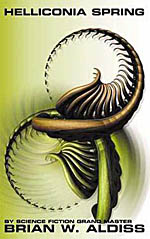
![]() Triseult
Triseult
7/4/2012
![]()
The Helliconia cycle is a SF trilogy with a planet as its main character. Yes, it's that epic and mind-boggling in scale. Heck, the prologue to the entire trilogy is a 100-page unbroken chapter. Helliconia Spring, the first of three novels in the cycle, tells the tale of a small human community as Spring comes to a world whose year lasts long enough for civilizations to rise and fall.
It goes without saying that the main feature of Aldiss' novel is his incredible world-building. In the Helliconia cycle, he not only introduces three competing civilizations, but a rich and unique ecology that encompasses animals, plants, even parasites and viruses that are uniquely suited to this world's peculiar climate. The whole is told with meticulous detail, and a portrait of a unique system in delicate balance emerges, with the two main sentient species, humans and phagors, waxing and waning with the seasons.
The bulk of Helliconia Spring tells the tale of a small village at the critical point when the long winter finally breaks and spring arrives to the world. Humans, pushed to the brink of savagery by the long winter and the ascendance of phagors, slowly emerge from their hiding places, and their civilization begins to flourish again. The events in Helliconia Spring cover a mere generation, which makes for a more intimate chronicle of humanity at a turning point. I have to say, I liked a lot of the themes and characters covered here. Given the incredible ambition of the world-building, it would have been easy to lose the characters in the backdrop. That does happen, but not as much as I expected.
The most interesting conflict in the book is between the men, who want unity and respect of tradition, and the women, who want to seek knowledge and better their condition. This tension is raised a few notches by the deep transformations happening the world over, making this choice of dramatic scale an illuminating one. I liked the women's struggle for independence and knowledge, faced with men who love them, but who believe that the proper way to love a woman is to possess her. The fact that they all belong to the same community, and ultimately feel for one another, makes the conflict even more gripping.
Ultimately, that tension fails to coalesce as the changes overcoming Helliconia take center stage. That desire to illustrate the transformations of the world, and the waxing of human influence, ends up diluting the dramatic arc. As much as I liked to read how humans were returning to a time of plenty after generations of hardships, I have a hard time believing that a handful of men and women rediscovered astronomy, heliocentric theory, currency-based economy, masonry, and horseback riding, within the span of a single generation. Perhaps real-life discussions on anthropology, such as Guns, Germs, and Steel have spoiled my ability to suspend disbelief in that matter.
I also feel that the main purpose of the book, to showcase the transformations happening in human civilization, may have been better served by the approach showcased in Kim Stanley Robinson's The Years of Rice and Salt, where we get periodic glimpses of individual stories throughout history. On the whole, the human stories get lost in the overall chaos of the world, especially considering that the sequel, Helliconia Summer, jumps ahead a few centuries.
The prose was engaging for the most part, with some clumsy parts. Some adverbs made me cringe. (Worst offender: "he said chantingly".) But for the most part, the descriptions were crisp, and the characters were well-rounded and interesting.
A strange concept featured in the novel is the human space station, orbiting above Helliconia, and studying the events happening on the surface in detail. That was a strange choice, and although I suspect it plays its part in subsequent novels, it was merely an odd framing device in this one. It's as if Aldiss was afraid we'd mistake his story for fantasy, and wanted to root it deeply in science fiction by throwing around references to space stations and scientific observations.
All in all, Helliconia Spring was a fascinating, if flawed read. I suspect the book should be considered only a part of an overall and self-contained story, but I'm not particularly attracted to the remaining novels. But that being said, I do come away fascinated and impressed by Aldiss' world-building skills. They are thorough and fascinating.